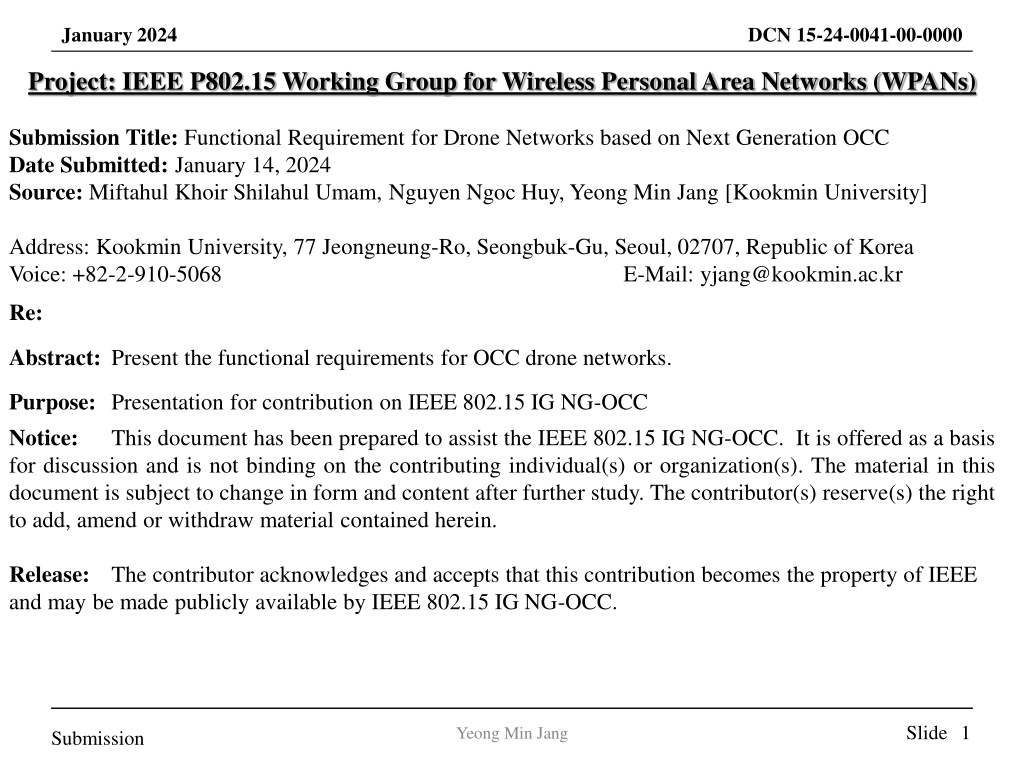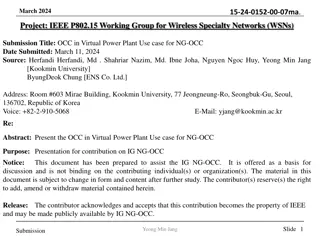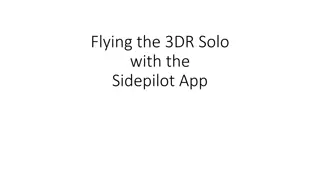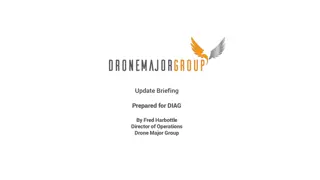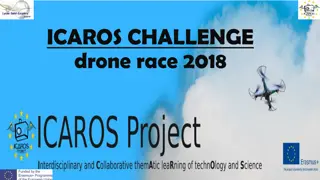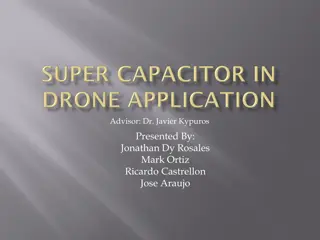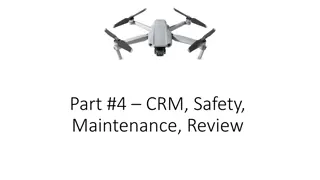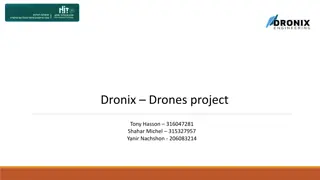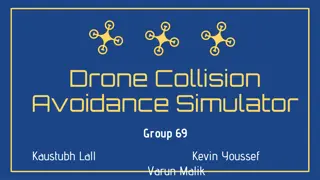Functional Requirements for Drone Networks with OCC
Explore the functional requirements for drone networks based on Next Generation OCC, offering secure communication, RF interference immunity, low latency, and high bandwidth. The system overview of a multi-drone system is discussed, showcasing how drones communicate, collaborate, and perform various tasks in a network architecture. Background information on drone networks and the components involved is provided, emphasizing their role in surveillance, data collection, delivery services, and more.
Download Presentation

Please find below an Image/Link to download the presentation.
The content on the website is provided AS IS for your information and personal use only. It may not be sold, licensed, or shared on other websites without obtaining consent from the author. Download presentation by click this link. If you encounter any issues during the download, it is possible that the publisher has removed the file from their server.
E N D
Presentation Transcript
January 2024 DCN 15-24-0041-00-0000 Project: IEEE P802.15 Working Group for Wireless Personal Area Networks (WPANs) Submission Title: Functional Requirement for Drone Networks based on Next Generation OCC Date Submitted: January 14, 2024 Source: Miftahul Khoir Shilahul Umam, Nguyen Ngoc Huy, Yeong Min Jang [Kookmin University] Address: Kookmin University, 77 Jeongneung-Ro, Seongbuk-Gu, Seoul, 02707, Republic of Korea Voice: +82-2-910-5068 E-Mail: yjang@kookmin.ac.kr Re: Abstract: Present the functional requirements for OCC drone networks. Purpose: Presentation for contribution on IEEE 802.15 IG NG-OCC Notice: This document has been prepared to assist the IEEE 802.15 IG NG-OCC. It is offered as a basis for discussion and is not binding on the contributing individual(s) or organization(s). The material in this document is subject to change in form and content after further study. The contributor(s) reserve(s) the right to add, amend or withdraw material contained herein. Release: The contributor acknowledges and accepts that this contribution becomes the property of IEEE and may be made publicly available by IEEE 802.15 IG NG-OCC. Slide 1 Yeong Min Jang Submission
January 2024 DCN 15-24-0041-00-0000 Functional Requirement for Drone Networks based on Next Generation OCC January 14, 2024 Slide 2 Yeong Min Jang Submission
January 2024 DCN 15-24-0041-00-0000 Contents Background System Overview of a Multi-Drone System Issues in Drone Network Communication Functional Requirements for OCC-based Drone Communication Conclusion Slide 3 Yeong Min Jang Submission
January 2024 DCN 15-24-0041-00-0000 Background A drone network refers to a system where multiple drones (Unmanned Aerial Vehicles or UAVs) communicate and collaborate with each other to perform specific tasks. These tasks can range from surveillance, monitoring, data collection, delivery services, and more. Drone networks can also provide on-demand communications for remote and hard-to-reach areas. OCC in drone networks provides more secure communication, immunity to RF interference, low latency, and higher bandwidth. Slide 4 Yeong Min Jang Submission
January 2024 System Overview of a Multi-Drone System DCN 15-24-0041-00-0000 In general [1], a multi-drone system is represented in Figure 1. Drone platform refers to the used vehicles, the software, and hardware associated with the low-level and high-level controls of these vehicles, and onboard processors. Sensing block is responsible for observing the environment and analyzing the collected data from the environment and/or other vehicles Communication and information to be shared between devices in the network (such as UAVs and ground control). Coordination block handles the decision-making (e.g., path planning and task sharing), which involves feedback and constraints processing from the remaining building blocks. The interactions between the blocks and the required functionality from each block are dependent on the goal of the system Networking block allows Fig 1. Multi-drone System Diagram Slide 5 Yeong Min Jang Submission
January 2024 Issues in Drone Network Communication DCN 15-24-0041-00-0000 Connectivity In the absence of sufficient communication infrastructure, it becomes essential to employ drones as intermediaries between unconnected ground stations. Unmanned Aerial Vehicles (UAVs), characterized by restricted communication ranges, high mobility, and limited energy resources (dependent on their battery levels), must ensure connectivity continuity. Consequently, the networking and scheduling protocols utilized in this context should be flexible enough to accommodate the dynamic nature of the environment. Routing and Scheduling To maintain connectivity and meet QoS requirements, protocols that support three-dimensional controlled mobility should be designed. Communications link models Models that capture the characteristics of UAV-UAV and UAV-ground links are needed since different types of UAVs (multi-copter or fixed-wing) have different layouts and constraints. Weather and environment also affect the channel model in optical communication. Data transmission The transmission of payload data, such as control information, sensor readings, images, and videos, must ensure that the application's QoS requirements (data rate, delay/latency, reliability) are met under varying network conditions. Slide 6 Yeong Min Jang Submission
January 2024 Functional Requirements for OCC-based Drone Communication DCN 15-24-0041-00-0000 Point-to-point communication. The system should support reliable and high-speed point-to-point communication between drones. A line-of-sight (LOS) link also needs to be ensured to maintain seamless communication between drones. Slide 7 Yeong Min Jang Submission
January 2024 Functional Requirements for OCC-based Drone Communication DCN 15-24-0041-00-0000 Target-drone detection and tracking To establish communication between two or more drones, robust detection methods need to be utilized for detecting the corresponding transmitters located in the targets. There are several methods to perform detection and tracking on OCC transmitters. Optical closed-loop control. [2] AI-based object detection (e.g., YOLO) Optical closed-loop control [2] Object detection Slide 8 Yeong Min Jang Submission
January 2024 Functional Requirements for OCC-based Drone Communication DCN 15-24-0041-00-0000 High mobility communication The mobility of drones will cause rapid shifts in the distance between the transmitter and the receiver. Drones constantly try to balance themselves in the air, resulting in frequent changes in orientation. Since drone systems operate in high mobility and high disturbance environments, a communication link that can handle the vibration of drones is required. A robust detection, tracking, or stabilization method can be utilized to assist the communication between drones. Energy efficiency Since UAVs have limited power sources, like batteries, it is important to perform energy-aware OCC that consumes minimum power. Excessive consumption of energy can limit the flight duration of drones, hence optimal OCC techniques need to be developed to reduce energy consumption. Channel Estimation Channel estimation is necessary to estimate the suitable parameter to establish optimal communication links between drones, such as modulation techniques. Different environmental conditions such as weather may affect the channel parameters of the OCC links. Slide 9 Yeong Min Jang Submission
January 2024 DCN 15-24-0041-00-0000 Conclusions OCC can be utilized in drone networks because it provides more secure communication, immunity to RF interference, low latency, and higher bandwidth. To develop a robust drone network based on OCC, it is necessary to ensure that the network allows point-to-point communication with LOS links, can detect and track target drones to communicate, can communicate in high mobility, and is power efficient. Slide10 Yeong Min Jang Submission
January 2024 DCN 15-24-0041-00-0000 References [1] E. Yanmaz, S. Yahyanejad, B. Rinner, H. Hellwagner, and C. Bettstetter, Drone networks: Communications, coordination, and sensing, Ad Hoc Networks, vol. 68, pp. 1 15, Jan. 2018, doi: 10.1016/j.adhoc.2017.09.001. [2] S. M. Walsh et al., Demonstration of 100 Gbps coherent free-space optical communications at LEO tracking rates, Sci Rep, vol. 12, no. 1, p. 18345, Oct. 2022, doi: 10.1038/s41598-022-22027-0. Slide 11 Yeong Min Jang Submission
